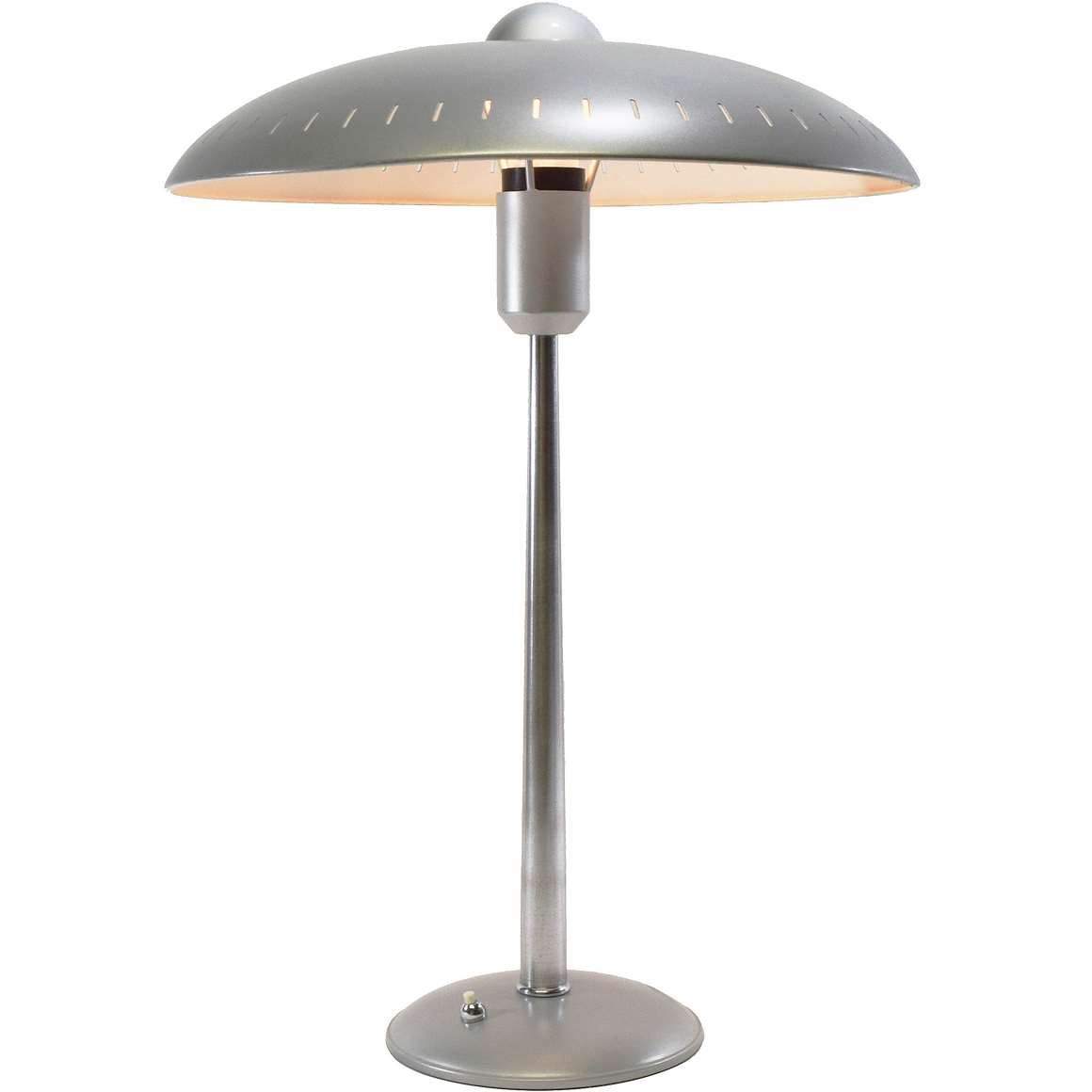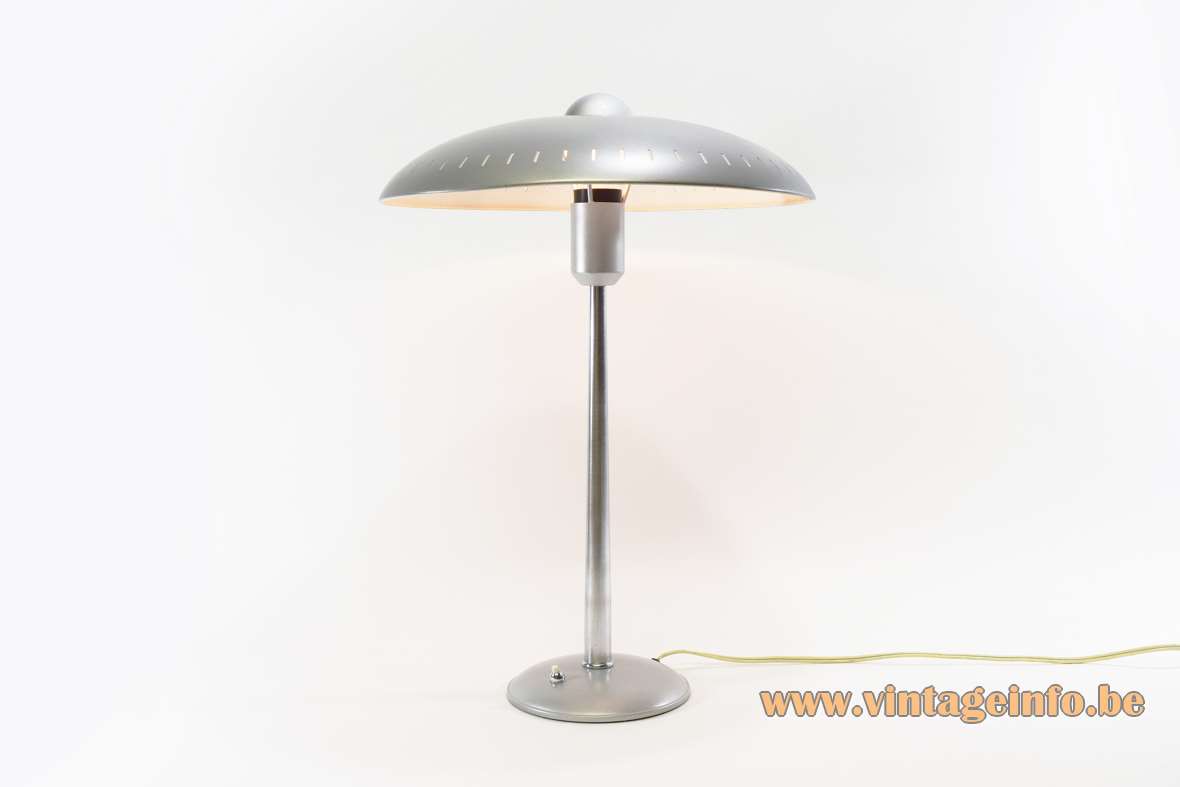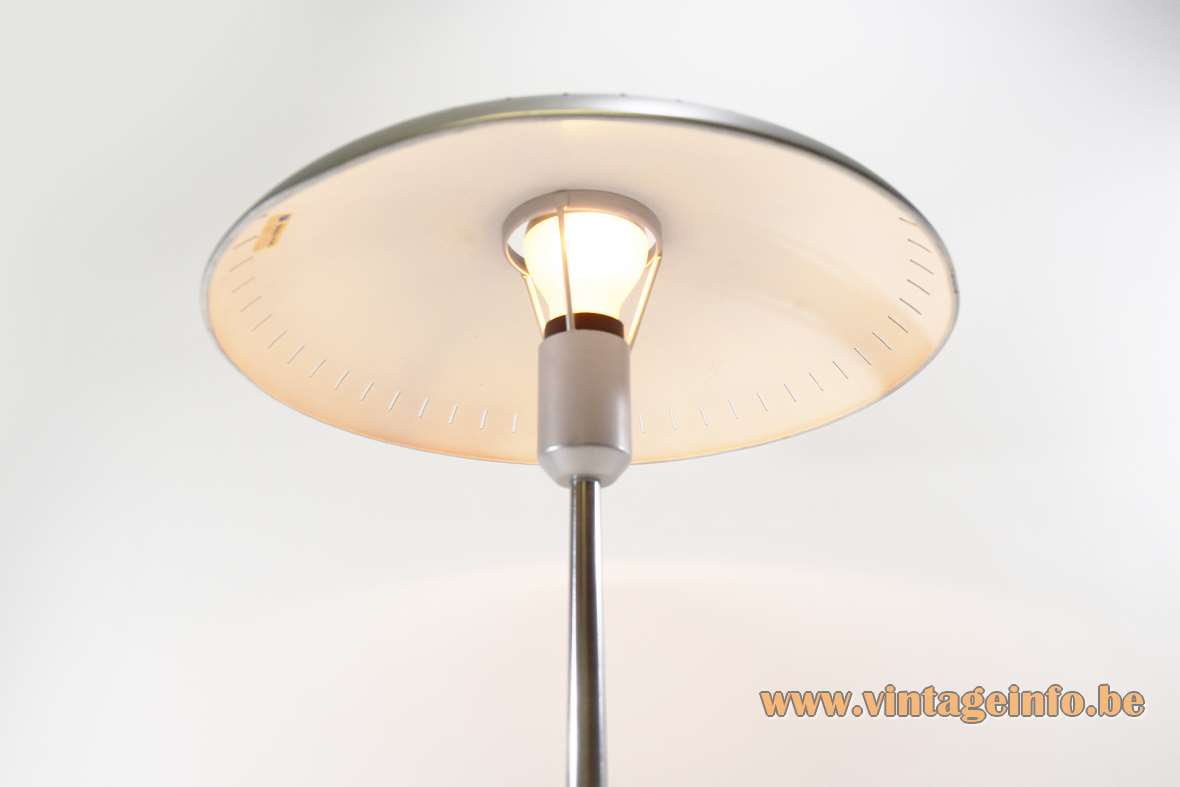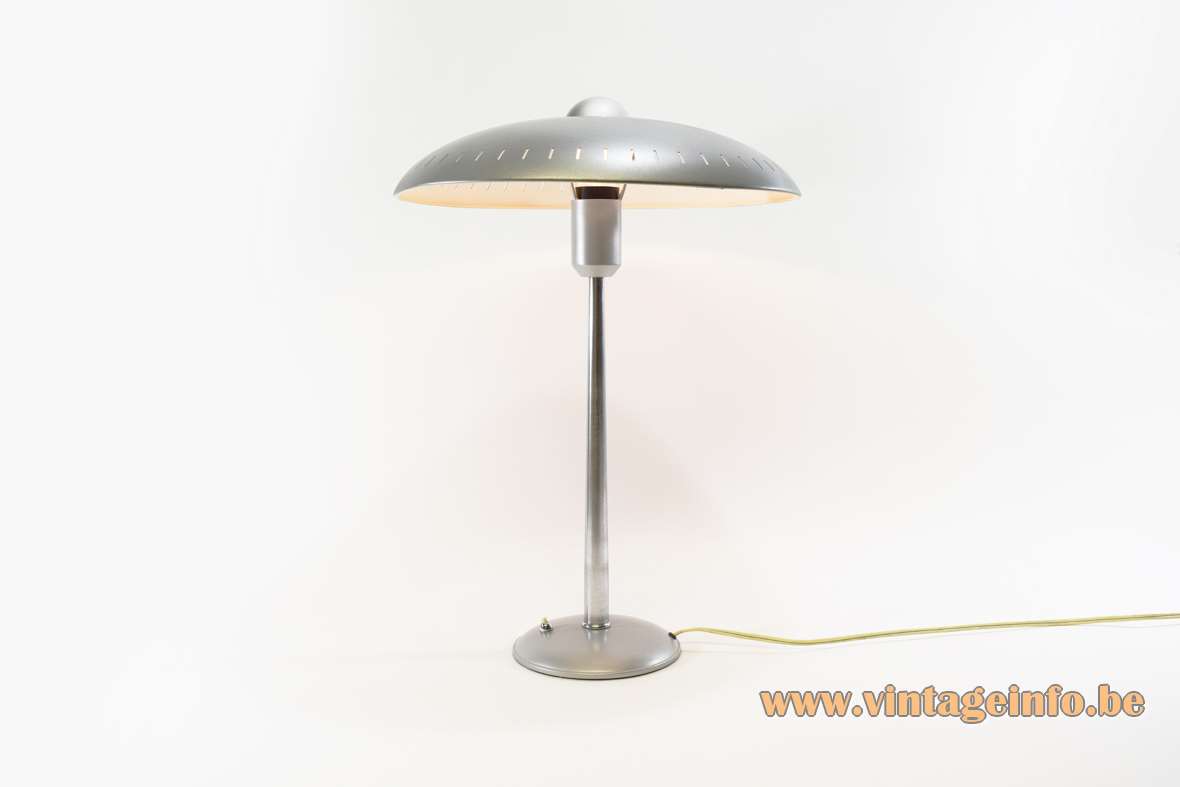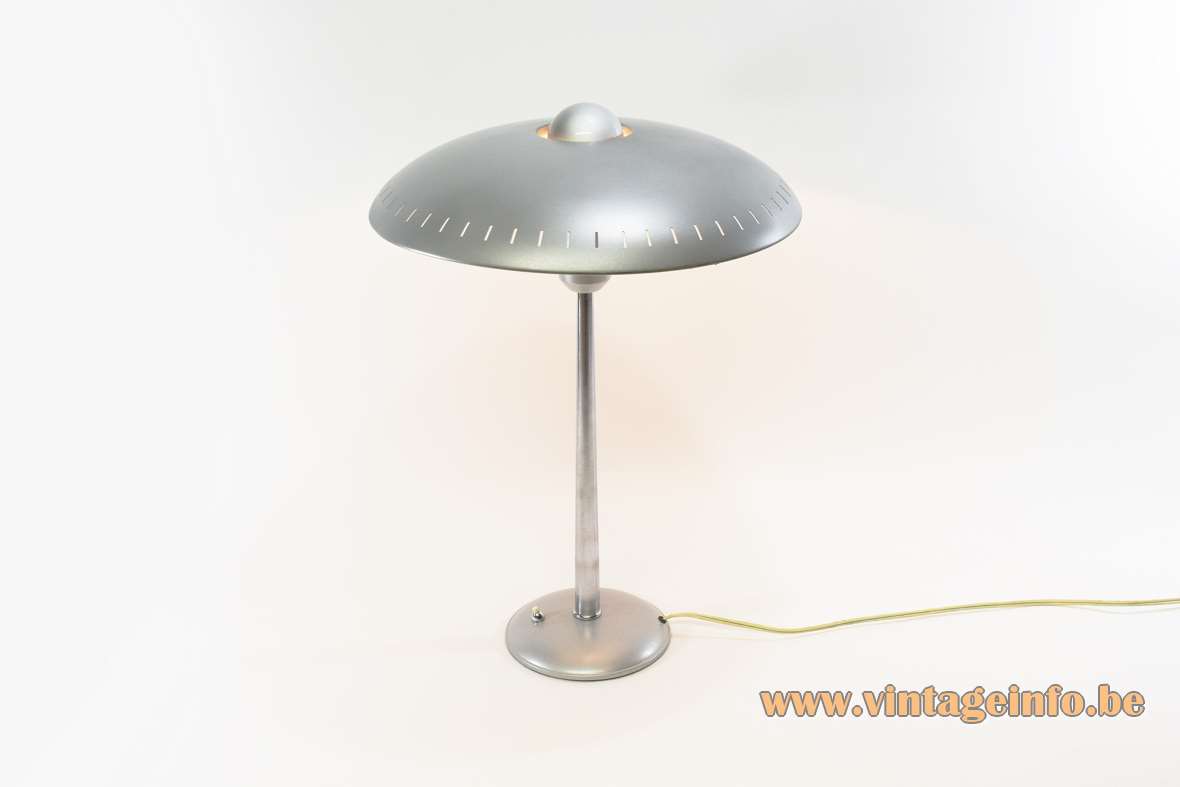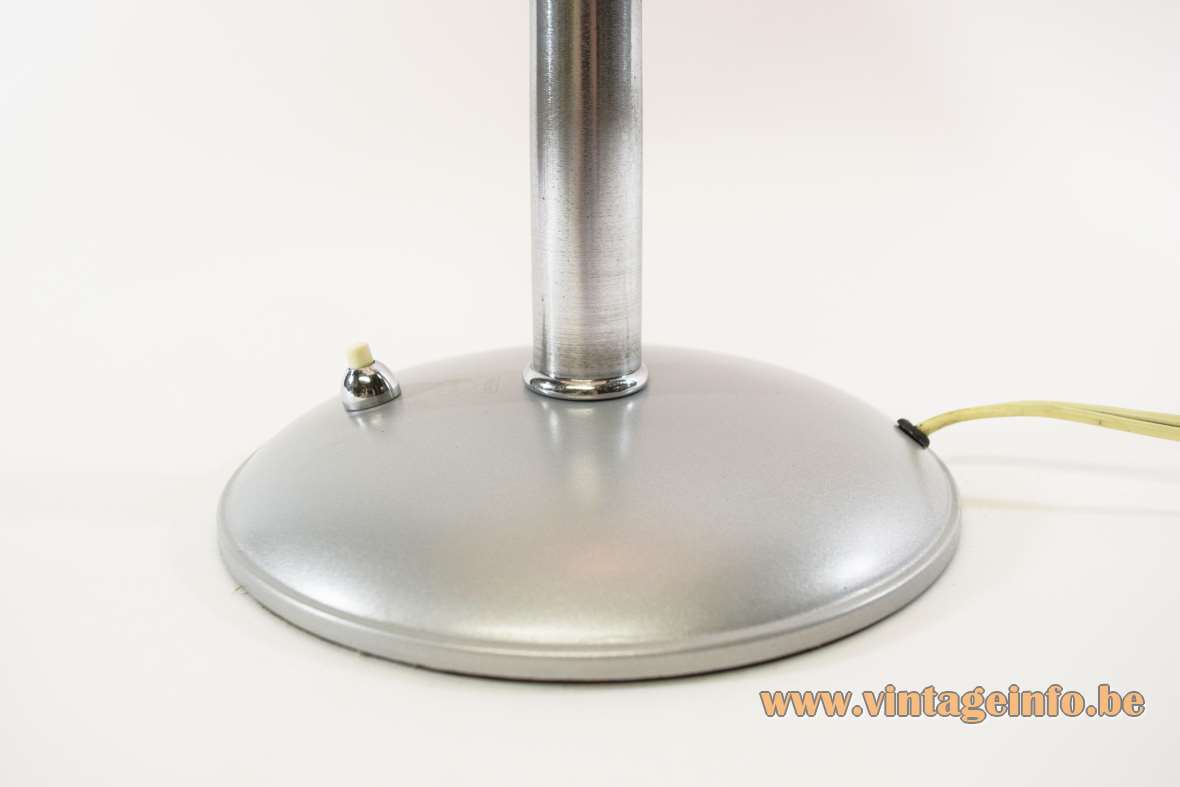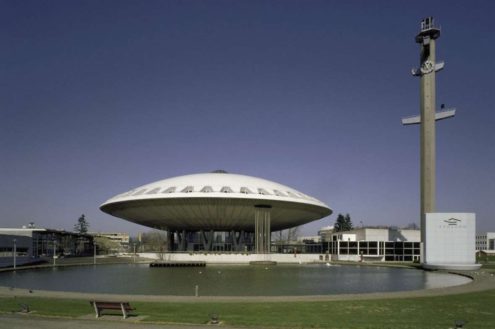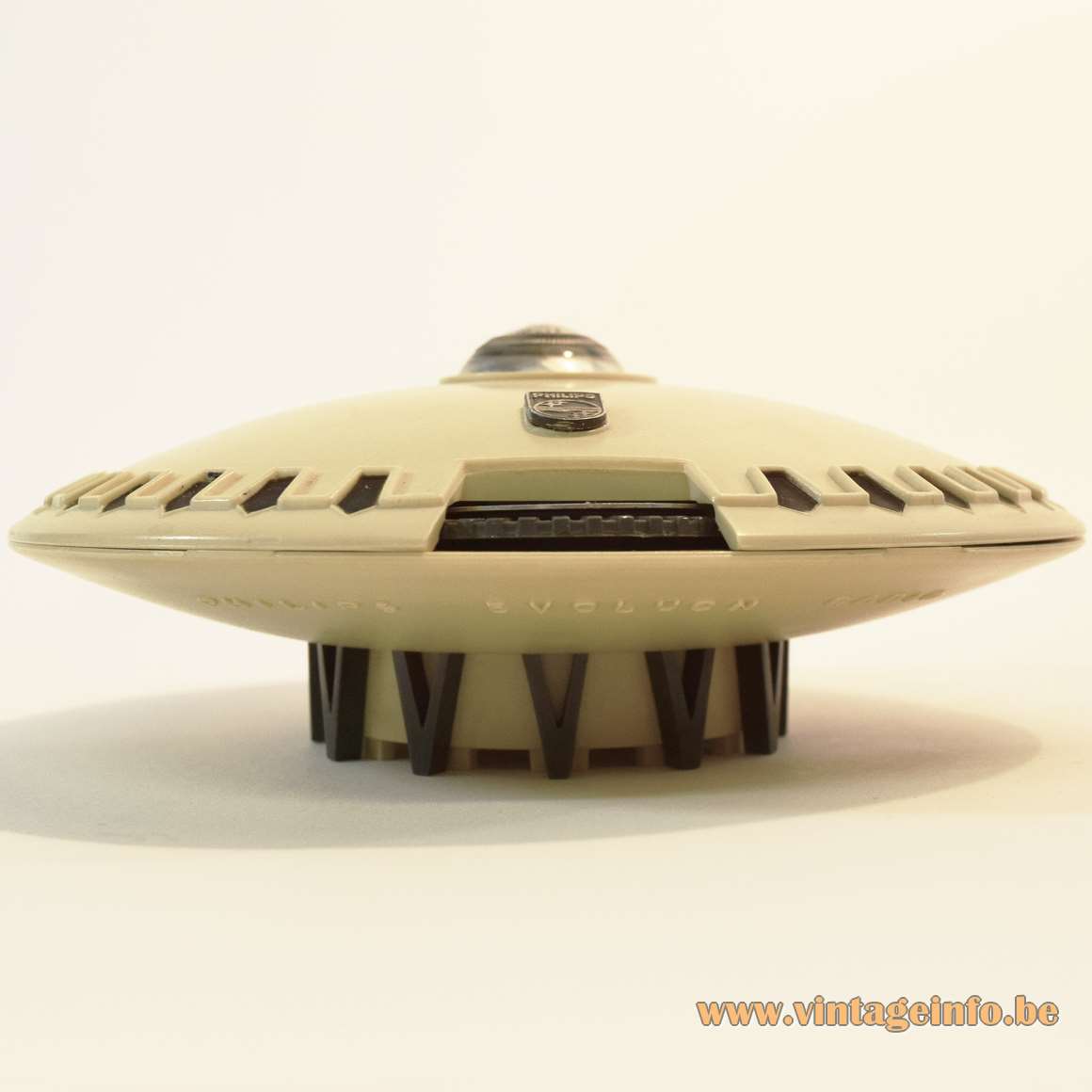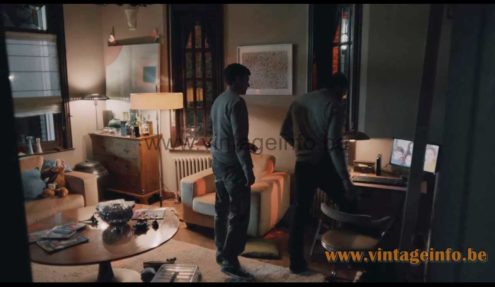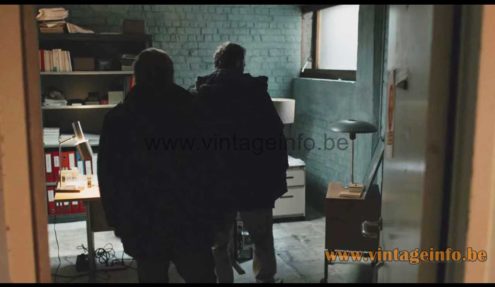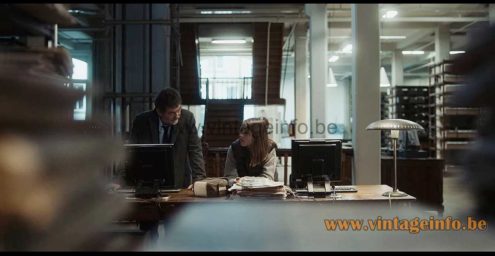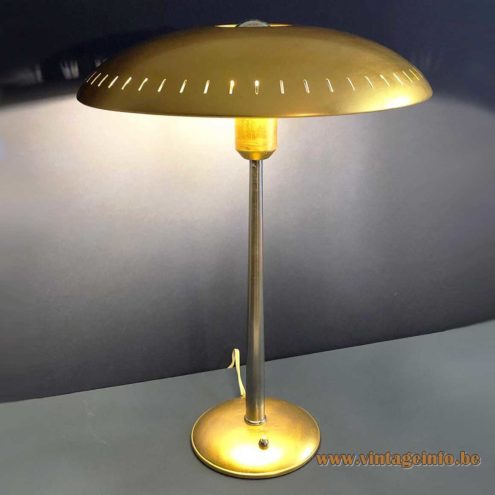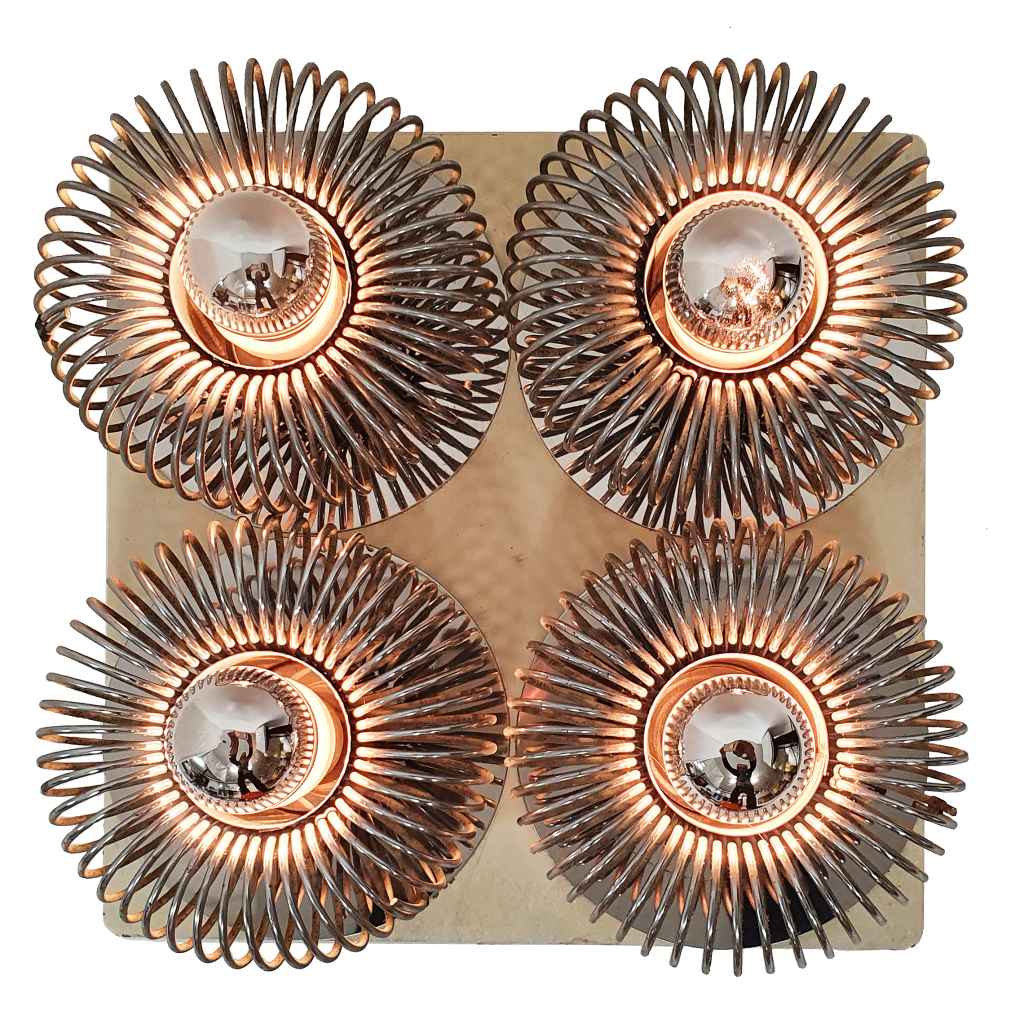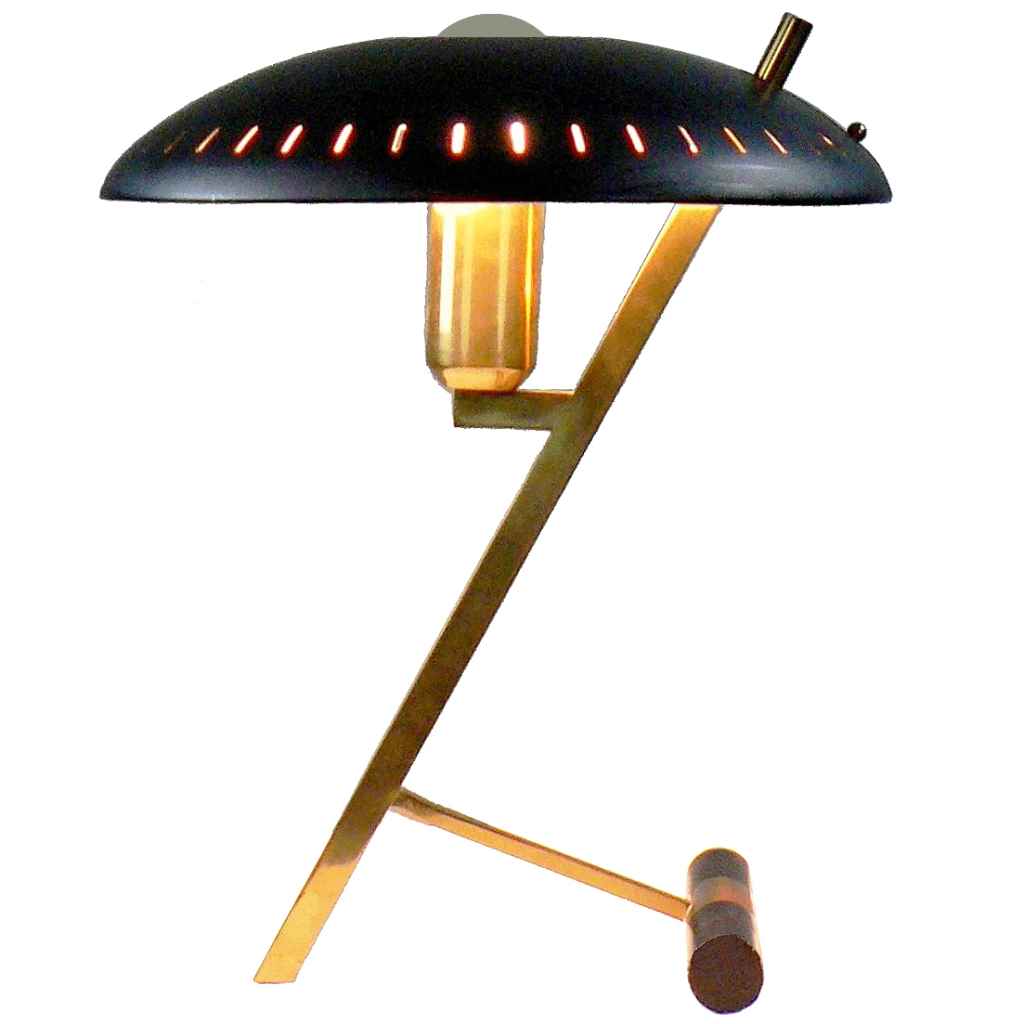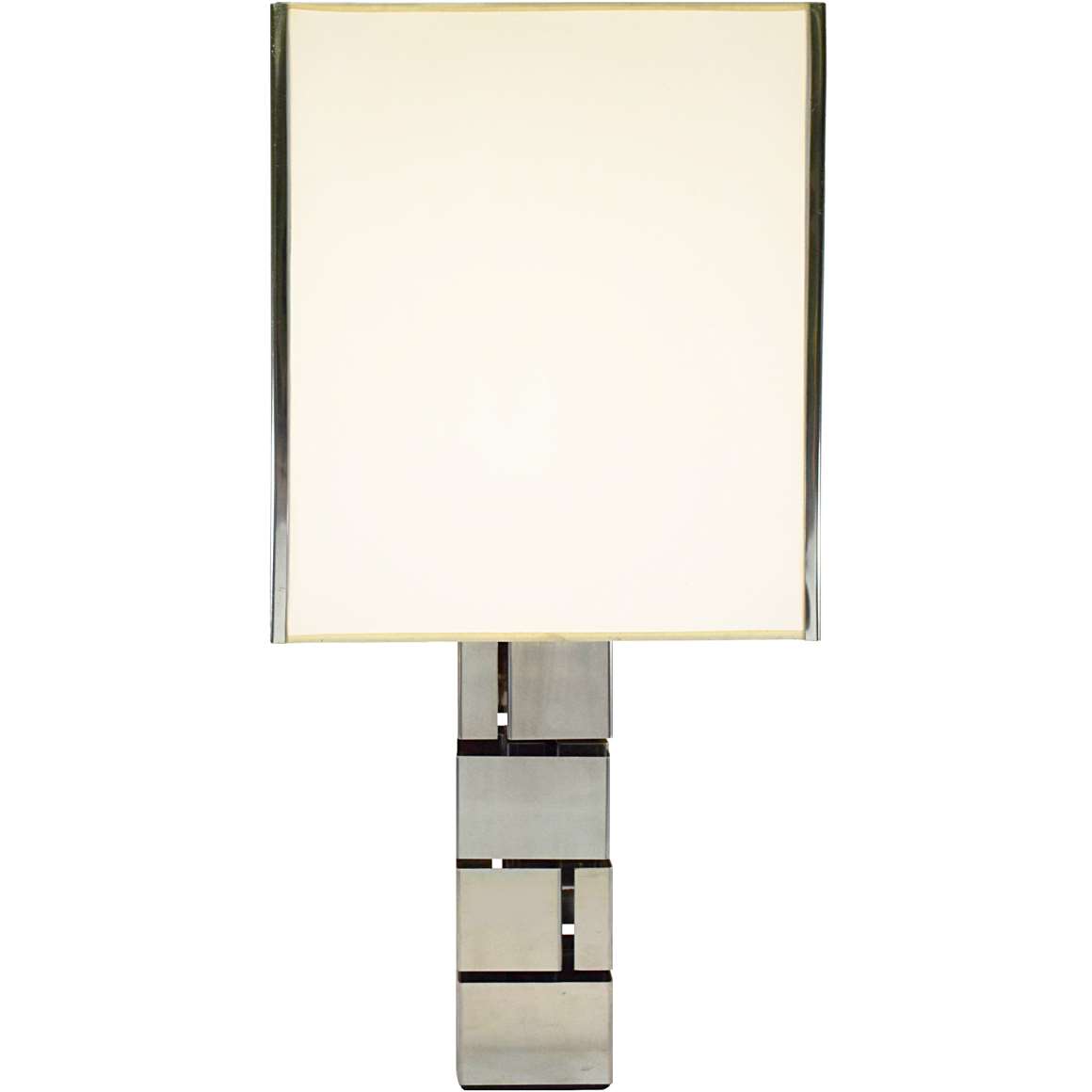Philips Senior Table Lamp
The Evoluon in Eindhoven, The Netherlands
Philips Senior Table Lamp
Philips logo stamped in the base and the successor, the Major desk lamp.
Philips Senior Table Lamp – Evoluon AM radio from the sixties
Made after the building in Eindhoven Louis Kalff designed. It was sold in the museum shop at the time.
Lamps In The Movies
Unité 42 (2017)
A 1950s Philips Senior table lamp was used as a set decoration in the 2017 Belgian television crime series Unité 42 (Unit 42). Starring Patrick Ridremont, Constance Gay and Tom Audenaert. It appears several times in the first episode, as you can see. Many other lamps appear in the series.
Les Rivières Pourpres (2018)
A dark grey 1950s Philips Senior table lamp was used as a set decoration in the French psychological thriller TV series Les Rivières Pourpres (The Crimson Rivers) from 2018. Starring Olivier Marchal and Erika Sainte. In the early 2000s 2 films were made with the same name and characters. The lead role was then played by Jean Reno. This is a follow-up series.
The Philips Senior table lamp appears in episode 3 of the first series and it was used 2 times, as you can see. In episode 5 it reappears, this time in an office in Roubaix, some 450 km – 280 mi from the other location. Several other lamps appear in this series. In episode 7 and 8 the lamp is located in a police office in Germany, near the French border.
Episode 5, in an office in Roubaix, France.
Episode 6 and 7, in an office in Germany.
Links (external links open in a new window)
Louis Kalff Industrial Design Heritage Centre website
The complete history of the Philips company on their website
The Evoluon building – Wikipedia
Website of the Philips Museum in Eindhoven
Louis Kalff – Wikipedia (only in Dutch)
Les Rivières Pourpres TV series – IMDb
Unit 42 (2017) TV series – Wikipedia
Unit 42 (2017) TV series – IMDb
Vintageinfo
Many thanks to Ger for the beautiful pictures.
Many thanks to Eric of Le Chaisanthrope for the photo of the gilded version.
Many thanks to Storm from Storm Vintage for the help.
Philips Senior Table Lamp
Materials: Round silver painted curved base, cast iron counterweight inside. Built-in switch. Stainless steel conical rod, brass rod inside. Silver painted aluminium mushroom lampshade with elongated slots and a whole in the middle. Painted white on the inside. Some metal parts. Chrome ring. Bakelite E27 socket.
Total Height: 56 cm / 22.04” – with light bulb
Height: 54 cm / 21.25”
Lampshade: ∅ 39,3 cm / 15.47”
Base: ∅ 17 cm / 6.69”
Electricity: 1 bulbE27, 1 x 100 watt maximum, 110/220 volt.
Anytypeof light bulb canbeused. But preferably a silver tipped light bulb of 100 watt. Bulbs from 60 watt are smaller. (use a dimmer…)
Period: 1950s, 1960s – Mid-Century Modern.
Designer: To be appraised.
Manufacturer:Philips, Eindhoven, The Netherlands.
Other versions: The Philips Senior table lamp comes in many different colours. It is also produced with a copper or brass rod. These lamps were made in several sizes. The biggest lamp, +- 60 cm / 23” high was for a 200 watt bulb. They were made in several varieties over the years. A blue, turquoise version with other parts can be found here, on Vintageinfo.
Below the successor from the seventies named Major or Consul. In the late seventies and early eighties it was named Timor (69).
Louis Christiaan Kalff (1897–1976)
Louis Kalff (Amsterdam, 14 November 1897 – Waalre, 16 September 1976) was the designer and art director who, more than anyone else, gave Philips a modern visual identity in the 1920s and 1930s. From 1925 onwards he worked at the Philips advertising department in Eindhoven, where he was asked to make the company’s advertising and presentation match the size and ambitions of the firm.
Philips house style and logo
When Kalff arrived, the name “Philips ” was written in many different ways. He standardised the lettering, the colours (he liked strong primary colours) and the overall layout of advertisements and packaging. In the second half of the 1920s he introduced the combination of waves and stars as symbols for radio transmission, first on packaging and later on products. In 1938 he brought the wordmark and the emblem together in the familiar Philips shield – one of his best-known contributions.
Besides the work for Philips he designed posters and graphic work for the Holland-America Line, Calvé, Zeebad Scheveningen, Holland Radio and others, always in the same clear, modern idiom.
Lighting and the LIBU (1929)
Because electric lighting in architecture was developing very fast, Kalff founded the Lichtadviesbureau (LIBU) in 1929. That bureau advised architects, municipalities and companies on how to use light in buildings, shops and public space. It did not only push Philips products, it also looked at what the market needed. Through the LIBU, Kalff organised the lighting for several world exhibitions, among them Barcelona, Antwerp and Paris.
From advertising to industrial design
After the Second World War the earlier “artistic propaganda” work inside Philips evolved into a broader industrial design service, later known as ARTO. Kalff was closely involved in this and for years he supervised the styling of radios, loudspeakers, domestic appliances and professional lighting installations. New products were often “kalfft ” first – checked for function, for looks and for recognisability as a Philips product.
Did he design the Philips lamps?
Many 1950s Philips lamps are offered today as “Louis Kalff ”. That sounds attractive, but it is not supported by Philips documentation. Kalff organised the lighting and design departments (LIBU, later ARTO), he approved designs and he set the taste, but there is no primary source that attributes specific desk or floor lamps to him personally. The similarity between his later architectural work (Evoluon) and some saucer-shaped Philips lamps, such as the Decora, Senior and Junior, simply shows that the same visual language was used inside Philips.
The story that he also designed lamps for German makers such as Cosack / Gecos is another internet repeat and has, as far as we know, no documentary basis.
Safer wording: “Philips lighting of the 1950s was developed within the design organisation created and led by Louis Kalff, but no individual lamp models can be firmly attributed to him.”
Architecture and later work
Next to graphic work Kalff also designed and co-designed buildings for Philips, such as the Dr. A.F. Philips Observatory in Eindhoven (1937) and houses for Philips directors. After his retirement in 1960 he remained active as advisor and architect. His best-known late project is the Evoluon in Eindhoven (opened 1966), designed with Leo de Bever, a futuristic disc-shaped building that perfectly fits the forward-looking image he had promoted at Philips for four decades.
Louis Kalff passed away in Waalre on 16 September 1976.
Louis Christiaan Kalff (1897–1976)
Louis Kalff (Amsterdam, 14 November 1897 – Waalre, 16 September 1976) was the designer and art director who, more than anyone else, gave Philips a modern visual identity in the 1920s and 1930s. From 1925 onwards he worked at the Philips advertising department in Eindhoven, where he was asked to make the company’s advertising and presentation match the size and ambitions of the firm.
Philips house style and logo
When Kalff arrived, the name “Philips ” was written in many different ways. He standardised the lettering, the colours (he liked strong primary colours) and the overall layout of advertisements and packaging. In the second half of the 1920s he introduced the combination of waves and stars as symbols for radio transmission, first on packaging and later on products. In 1938 he brought the wordmark and the emblem together in the familiar Philips shield – one of his best-known contributions.
Besides the work for Philips he designed posters and graphic work for the Holland-America Line, Calvé, Zeebad Scheveningen, Holland Radio and others, always in the same clear, modern idiom.
Lighting and the LIBU (1929)
Because electric lighting in architecture was developing very fast, Kalff founded the Lichtadviesbureau (LIBU) in 1929. That bureau advised architects, municipalities and companies on how to use light in buildings, shops and public space. It did not only push Philips products, it also looked at what the market needed. Through the LIBU, Kalff organised the lighting for several world exhibitions, among them Barcelona, Antwerp and Paris.
From advertising to industrial design
After the Second World War the earlier “artistic propaganda” work inside Philips evolved into a broader industrial design service, later known as ARTO. Kalff was closely involved in this and for years he supervised the styling of radios, loudspeakers, domestic appliances and professional lighting installations. New products were often “kalfft ” first – checked for function, for looks and for recognisability as a Philips product.
Did he design the Philips lamps?
Many 1950s Philips lamps are offered today as “Louis Kalff ”. That sounds attractive, but it is not supported by Philips documentation. Kalff organised the lighting and design departments (LIBU, later ARTO), he approved designs and he set the taste, but there is no primary source that attributes specific desk or floor lamps to him personally. The similarity between his later architectural work (Evoluon) and some saucer-shaped Philips lamps, such as the Decora, Senior and Junior, simply shows that the same visual language was used inside Philips.
The story that he also designed lamps for German makers such as Cosack / Gecos is another internet repeat and has, as far as we know, no documentary basis.
Safer wording: “Philips lighting of the 1950s was developed within the design organisation created and led by Louis Kalff, but no individual lamp models can be firmly attributed to him.”
Architecture and later work
Next to graphic work Kalff also designed and co-designed buildings for Philips, such as the Dr. A.F. Philips Observatory in Eindhoven (1937) and houses for Philips directors. After his retirement in 1960 he remained active as advisor and architect. His best-known late project is the Evoluon in Eindhoven (opened 1966), designed with Leo de Bever, a futuristic disc-shaped building that perfectly fits the forward-looking image he had promoted at Philips for four decades.
Louis Kalff passed away in Waalre on 16 September 1976.
Philips Senior Table Lamp – 1960 Catalogue Picture
Philips Senior table lamp – Gold Plated Edition
Gold plated unique version, created by Hervé Gehler. Commissioned by Eric Brusson for Le Chaisanthrope, Paris, France.
